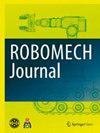下肢外骨骼辅助装置粘滞特性的验证:通过测量肌肉活动验证辅助效果
IF 1.7
Q3 INSTRUMENTS & INSTRUMENTATION
引用次数: 0
摘要
由于外骨骼辅助装置是由人直接佩戴的,因此加强配合非常重要。然而,现有的辅助设备在与人类行为的配合方面存在问题。这是因为现有的辅助设备是基于预定的运动时间和设备角度信息来估计佩戴者的运动意图来驱动的。虽然这些方法都能达到预期的效果,但在实际操作中,很难达到预期的效果。因此,需要一种辅助方法来减少这种随时间的不对准以及装置与佩戴者之间的不对准。因此,本研究的重点是粘弹性特性,它在响应运动时产生力,并有望增强协调性。在之前的一项研究中,作者证实了粘弹性特性或可变刚度辅助装置的影响。然而,运动过程中的粘性特性并没有被考虑。在本研究中,我们旨在通过关注粘性特性来改善协调性。响应角速度的粘性扭矩输出预计将响应于实际的人体运动。本研究将粘性力矩计算为指令粘性系数与关节角速度的乘积,并应用于一种具有磁粘性流体制动器和行星齿轮机构的下肢外骨骼式辅助装置。此外,将根据速度变化扭矩的粘性指令(提出的方法)、根据时间推移改变输出值的时间指令和根据设备角度信息改变指令值的角度指令应用于辅助装置,并将表面肌电测量结果与指令信号进行比较。目标运动为坐式运动,测量左右股内侧肌和半膜肌。在所有三种命令方法下,超过一半的受试者表现出肌电位下降,证实了粘性命令的有效性。本文章由计算机程序翻译,如有差异,请以英文原文为准。
Validation of a lower limb exoskeleton assist device focusing on viscous properties: verification of assist effectiveness by measuring muscle activity
Abstract Because exoskeletal assistive devices are worn directly by a person, enhancing cooperation is important. However, existing assistive devices have problems in terms of their cooperation with human behaviors. This is because existing assistive devices are driven by estimating the wearer’s movement intention based on predetermined movement time and device angle information. Although these methods are expected to work as expected, in practice, it is difficult to achieve the expected behavior. Therefore, an assistance method is required to reduce such misalignment with time and misalignment between the device and wearer. Therefore, this study focused on the viscoelastic properties that generate force in response to movement and are expected to enhance coordination. In a previous study, the authors confirmed the effects of viscoelastic properties or an assistive device with variable stiffness. However, viscous characteristics during movement have not been considered. In this study, we aimed to improve the coordination by focusing on the viscous characteristics. The viscous torque outputs in response to the angular velocity are expected to be driven in response to actual human motion. In this study, the viscous torque was calculated as the product of the command viscosity coefficient and the joint angular velocity and was applied to a lower-limb exoskeleton-type assist device equipped with a magneto-viscous fluid brake and a planetary gear mechanism. In addition, a viscous command that changes the torque according to speed (proposed method), a time command that changes the output value according to the passage of time, and an angle command that changes the command value according to the angle information of the device were applied to the assist device, and surface EMG measurements and command signals were compared. The target movement was a seated movement, and the left and right vastus medialis and semimembranosus muscles were measured. More than half of the subjects showed a decrease in myopotential for five subjects for all three command methods, confirming the effectiveness of the viscous command.
求助全文
通过发布文献求助,成功后即可免费获取论文全文。
去求助
来源期刊

ROBOMECH Journal
Mathematics-Control and Optimization
CiteScore
3.20
自引率
7.10%
发文量
21
审稿时长
13 weeks
期刊介绍:
ROBOMECH Journal focuses on advanced technologies and practical applications in the field of Robotics and Mechatronics. This field is driven by the steadily growing research, development and consumer demand for robots and systems. Advanced robots have been working in medical and hazardous environments, such as space and the deep sea as well as in the manufacturing environment. The scope of the journal includes but is not limited to: 1. Modeling and design 2. System integration 3. Actuators and sensors 4. Intelligent control 5. Artificial intelligence 6. Machine learning 7. Robotics 8. Manufacturing 9. Motion control 10. Vibration and noise control 11. Micro/nano devices and optoelectronics systems 12. Automotive systems 13. Applications for extreme and/or hazardous environments 14. Other applications
 求助内容:
求助内容: 应助结果提醒方式:
应助结果提醒方式:


